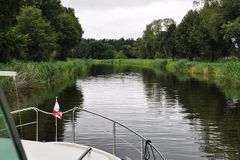Inland navigation

|
| Description |
| inland navigation along rivers, canals and on lakes and other waterways. |
| Group |
| Tags |
Inland navigation explains how to add tags to waterways (rivers, canals and lakes) that are provide information about the availability of particular stretches of water for navigation purposes by various types of vessel from large ships on major waterways, to pleasure boats or other craft.
Tags
Limitations
Limitations of the size or speed of vessels using the waterway at a particular point.
- tags denoting maximum permitted vessel's height (consolidation needed):
- maxheight=* is used to mark headroom or clearance under a bridge, tunnel or other obstruction that limits the available height. The maxheight tag is normally applied to a node on the lower way or on the way itself. The tag is not used on the bridge, but on the waterway that passes under the bridge.
- height=* (actual)
- headroom=* (actual)
- four tags denoting maximum permitted vessel's draft (consolidation needed):
- maxdraft=* (legal restriction)
- maxdraught=* (legal restriction)
- draft=* (actual)
- depth=* (actual)
- two tags denoting maximum permitted vessel's width (consolidation needed):
- two tags denoting maximum permitted vessel's length (consolidation needed):
- maxspeed=* (legal restriction) speed limit on the waterway. km/h assumed.
Add ' knots' to the value if this is the unit used, for example maxspeed=10 knots
Information
- disused=yes marks obstacles which are not available for use. They may later be reopened or may be permanently unavailable. For long terms, e.g. locks under repair.
- opening_hours=* opening hours of locks, lifts or draw brides. e.g. Apr-Sep: 9:00-18:00. Outside of these times navigation will not be possible.
- website=* URL of the website of locks, lifts etc.
- email=* email address to contact personnel of a lock, opening bridge etc.
- phone=* phone number to personnel.
- fax=* fax number to contact personnel.
- vhf=* VHF channel to contact personnel by radio.
- vhf_channel=* VHF channel to contact personnel by radio.
- vhf_mmsi=*
 MMSI number to contact personnel by radio.
MMSI number to contact personnel by radio.
In contrast with roads and path tagged with highway=*, waterways (tagged with waterway=*) by default do not imply that these can or may be navigated by vessels of any size (including recreational vessels and unpowered craft such as kayaks).
To mark a waterway as ![]() navigable in the sense of forming part of an inland water transport system, one of these tags must be used:
navigable in the sense of forming part of an inland water transport system, one of these tags must be used:
For recreational vessels, these tags may be used:
Locks
Locks are an important potential obstacle on waterways, especially regarding opening times. They should be tagged as describe in lock=*. The above tags as applicable are tagged one the way between the lock gates waterway=lock_gate.
- see also Seamarks/Seamark_Objects > lock_basin
Gates
- see Seamarks/Gates
Bridges
- see Seamarks/Bridges
others: Cable, Pipeline, Contours, Soundings, ...
Rendering
Routing
Proposals
The use of the following tags has been suggested or trialed. Status is not currently known. All measurements are in meters unless otherwise stated in the value.
- maxdraft=* or maxdraught=* maximum draught of a water-borne craft that is suitable or allowed.
- maxairdraft=* maximum permitted vessel height AWL.
- maxclosedheight=* headroom or clearance when a feature (such as a swing-bridge) is closed. ← See also: seamark:bridge:clearance_height_closed=*
- maxheight_referencelevel=* water reverence level of the waterway.
- maxsideheight=* headroom or clearance at the lowest part of the fairway (for example at the sides of channel under an arched bridge.
- passage_time=* usual time needed to pass through a lock or similar.
- CEMT=* European standard for sizes of vessels that can use a waterway.
- waterway=milestone Waterway distance milestones should be set at full kilometers as described in DE:key:waterway. They should be tagged at obstacles too, because their position is mostly exactly known, while the full kilometers will be rather inaccurate, even if marked by a sign on the riverbank.
See Also
- WikiProject Europe/E-waterway network The network of inland waterways in Europe and its parameters
- OpenSeaMap/CEVNI Notice Marks used in European Inland Waterways
- OpenSeaMap/CEVNI Lateral Marks used in European Inland Waterways
- OpenSeaMap/Harbour Information
- Marine navigation - Mapping for marine navigation
- Whitewater sports - for canoeing and rafting on fast-flowing watercourses.